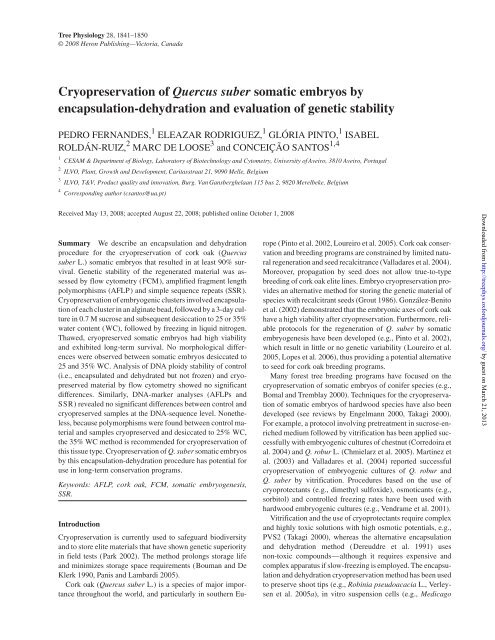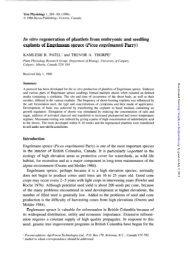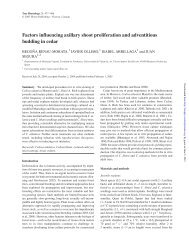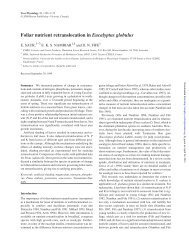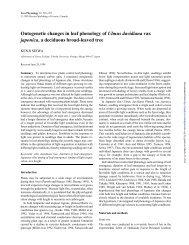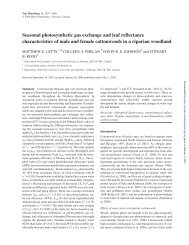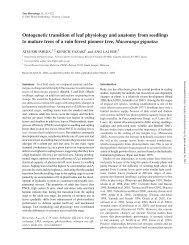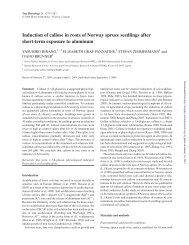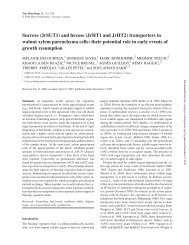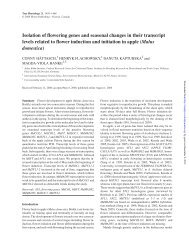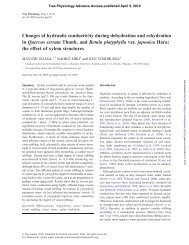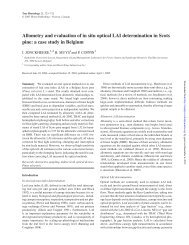Cryopreservation of Quercus suber somatic embryos - Tree Physiology
Cryopreservation of Quercus suber somatic embryos - Tree Physiology
Cryopreservation of Quercus suber somatic embryos - Tree Physiology
Create successful ePaper yourself
Turn your PDF publications into a flip-book with our unique Google optimized e-Paper software.
<strong>Tree</strong> <strong>Physiology</strong> 28, 1841–1850<br />
© 2008 Heron Publishing—Victoria, Canada<br />
<strong>Cryopreservation</strong> <strong>of</strong> <strong>Quercus</strong> <strong>suber</strong> <strong>somatic</strong> <strong>embryos</strong> by<br />
encapsulation-dehydration and evaluation <strong>of</strong> genetic stability<br />
PEDRO FERNANDES, 1 ELEAZAR RODRIGUEZ, 1 GLÓRIA PINTO, 1 ISABEL<br />
ROLDÁN-RUIZ, 2 MARC DE LOOSE 3 and CONCEIÇÃO SANTOS 1,4<br />
1<br />
CESAM & Department <strong>of</strong> Biology, Laboratory <strong>of</strong> Biotechnology and Cytometry, University <strong>of</strong> Aveiro, 3810 Aveiro, Portugal<br />
2<br />
ILVO, Plant, Growth and Development, Caritasstraat 21, 9090 Melle, Belgium<br />
3<br />
ILVO, T&V, Product quality and innovation, Burg. Van Gansberghelaan 115 bus 2, 9820 Merelbeke, Belgium<br />
4 Corresponding author (csantos@ua.pt)<br />
Received May 13, 2008; accepted August 22, 2008; published online October 1, 2008<br />
Summary We describe an encapsulation and dehydration<br />
procedure for the cryopreservation <strong>of</strong> cork oak (<strong>Quercus</strong><br />
<strong>suber</strong> L.) <strong>somatic</strong> <strong>embryos</strong> that resulted in at least 90% survival.<br />
Genetic stability <strong>of</strong> the regenerated material was assessed<br />
by flow cytometry (FCM), amplified fragment length<br />
polymorphisms (AFLP) and simple sequence repeats (SSR).<br />
<strong>Cryopreservation</strong> <strong>of</strong> embryogenic clusters involved encapsulation<br />
<strong>of</strong> each cluster in an alginate bead, followed by a 3-day culture<br />
in 0.7 M sucrose and subsequent desiccation to 25 or 35%<br />
water content (WC), followed by freezing in liquid nitrogen.<br />
Thawed, cryopreserved <strong>somatic</strong> <strong>embryos</strong> had high viability<br />
and exhibited long-term survival. No morphological differences<br />
were observed between <strong>somatic</strong> <strong>embryos</strong> desiccated to<br />
25 and 35% WC. Analysis <strong>of</strong> DNA ploidy stability <strong>of</strong> control<br />
(i.e., encapsulated and dehydrated but not frozen) and cryopreserved<br />
material by flow cytometry showed no significant<br />
differences. Similarly, DNA-marker analyses (AFLPs and<br />
SSR) revealed no significant differences between control and<br />
cryopreserved samples at the DNA-sequence level. Nonetheless,<br />
because polymorphisms were found between control material<br />
and samples cryopreserved and desiccated to 25% WC,<br />
the 35% WC method is recommended for cryopreservation <strong>of</strong><br />
this tissue type. <strong>Cryopreservation</strong> <strong>of</strong> Q. <strong>suber</strong> <strong>somatic</strong> <strong>embryos</strong><br />
by this encapsulation-dehydration procedure has potential for<br />
use in long-term conservation programs.<br />
Keywords: AFLP, cork oak, FCM, <strong>somatic</strong> embryogenesis,<br />
SSR.<br />
Introduction<br />
<strong>Cryopreservation</strong> is currently used to safeguard biodiversity<br />
and to store elite materials that have shown genetic superiority<br />
in field tests (Park 2002). The method prolongs storage life<br />
and minimizes storage space requirements (Bouman and De<br />
Klerk 1990, Panis and Lambardi 2005).<br />
Cork oak (<strong>Quercus</strong> <strong>suber</strong> L.) is a species <strong>of</strong> major importance<br />
throughout the world, and particularly in southern Eu-<br />
rope (Pinto et al. 2002, Loureiro et al. 2005). Cork oak conservation<br />
and breeding programs are constrained by limited natural<br />
regeneration and seed recalcitrance (Valladares et al. 2004).<br />
Moreover, propagation by seed does not allow true-to-type<br />
breeding <strong>of</strong> cork oak elite lines. Embryo cryopreservation provides<br />
an alternative method for storing the genetic material <strong>of</strong><br />
species with recalcitrant seeds (Grout 1986). González-Benito<br />
et al. (2002) demonstrated that the embryonic axes <strong>of</strong> cork oak<br />
have a high viability after cryopreservation. Furthermore, reliable<br />
protocols for the regeneration <strong>of</strong> Q. <strong>suber</strong> by <strong>somatic</strong><br />
embryogenesis have been developed (e.g., Pinto et al. 2002),<br />
which result in little or no genetic variability (Loureiro et al.<br />
2005, Lopes et al. 2006), thus providing a potential alternative<br />
to seed for cork oak breeding programs.<br />
Many forest tree breeding programs have focused on the<br />
cryopreservation <strong>of</strong> <strong>somatic</strong> <strong>embryos</strong> <strong>of</strong> conifer species (e.g.,<br />
Bomal and Tremblay 2000). Techniques for the cryopreservation<br />
<strong>of</strong> <strong>somatic</strong> <strong>embryos</strong> <strong>of</strong> hardwood species have also been<br />
developed (see reviews by Engelmann 2000, Takagi 2000).<br />
For example, a protocol involving pretreatment in sucrose-enriched<br />
medium followed by vitrification has been applied successfully<br />
with embryogenic cultures <strong>of</strong> chestnut (Corredoira et<br />
al. 2004) and Q. robur L. (Chmielarz et al. 2005). Martinez et<br />
al. (2003) and Valladares et al. (2004) reported successful<br />
cryopreservation <strong>of</strong> embryogenic cultures <strong>of</strong> Q. robur and<br />
Q. <strong>suber</strong> by vitrification. Procedures based on the use <strong>of</strong><br />
cryoprotectants (e.g., dimethyl sulfoxide), osmoticants (e.g.,<br />
sorbitol) and controlled freezing rates have been used with<br />
hardwood embryogenic cultures (e.g., Vendrame et al. 2001).<br />
Vitrification and the use <strong>of</strong> cryoprotectants require complex<br />
and highly toxic solutions with high osmotic potentials, e.g.,<br />
PVS2 (Takagi 2000), whereas the alternative encapsulation<br />
and dehydration method (Dereuddre et al. 1991) uses<br />
non-toxic compounds—although it requires expensive and<br />
complex apparatus if slow-freezing is employed. The encapsulation<br />
and dehydration cryopreservation method has been used<br />
to preserve shoot tips (e.g., Robinia pseudoacacia L., Verleysen<br />
et al. 2005a), in vitro suspension cells (e.g., Medicago<br />
Downloaded from<br />
http://treephys.oxfordjournals.org/ by guest on March 21, 2013
1842 FERNANDES ET AL.<br />
sativa L., Shibli et al. 2001) and <strong>somatic</strong> <strong>embryos</strong> and embryogenic<br />
masses (e.g., C<strong>of</strong>fea canephora Pierre ex Froehn,<br />
Tessereau et al. 1994; Citrus sp., Malik et al. 2006; Melea sp.,<br />
Scocchi et al. 2007) but its use has never been reported for the<br />
Fagaceae. Therefore, our first objective was to develop a<br />
non-toxic, inexpensive protocol for cryopreservation by encapsulation-dehydration<br />
for cork oak <strong>somatic</strong> <strong>embryos</strong>.<br />
<strong>Cryopreservation</strong> exposes plant material to stresses that<br />
may affect its genetic stability (see review by Panis and Lambardi<br />
2005). Therefore, our second objective was to evaluate<br />
the genetic stability <strong>of</strong> the cryopreserved <strong>somatic</strong> <strong>embryos</strong> after<br />
thawing based on three techniques—flow cytometry<br />
(FCM), amplified fragment length polymorphisms (AFLP)<br />
and simple sequence repeats (SSR). Flow cytometry (FCM),<br />
which has been used to provide a check on ploidy <strong>of</strong> in vitro<br />
cultures <strong>of</strong> hardwood species (e.g., Conde et al. 2004, Pinto et<br />
al. 2004, Loureiro et al. 2005, 2007b, Leal et al. 2006), was<br />
used to assess the ploidy <strong>of</strong> cryopreserved <strong>somatic</strong> <strong>embryos</strong> after<br />
thawing. We also checked for somaclonal variability based<br />
on amplified fragment length polymorphisms (AFLP) and<br />
simple sequence repeats (SSR). The AFLP is a sensitive<br />
multi-locus fingerprinting technique (Wilkinson et al. 2003)<br />
that has been used to assess genetic diversity in the <strong>Quercus</strong><br />
genus (Hornero et al. 2001, Coart et al. 2002, Ishida et al.<br />
2003) and to evaluate the genetic stability <strong>of</strong> cryopreserved<br />
material <strong>of</strong> hardwood species (Liu et al. 2004). The<br />
microsatellite (SSR) marker technique has previously been<br />
used to evaluate genetic stability in in vitro cultures (Liu et al.<br />
2008) and in cork oak emblings (Lopes et al. 2006) based on<br />
primers developed for other <strong>Quercus</strong> species (e.g., Isagi and<br />
Suhandono 1997, Steinkellner et al. 1997, Kampfer et al.<br />
1998).<br />
Materials and methods<br />
Plant material and growth conditions<br />
We studied <strong>somatic</strong> embryogenic clusters (2.5-mm diameter<br />
on average) at the globular stage induced from an ~80-year-old<br />
<strong>Quercus</strong> <strong>suber</strong> (genotype G0) tree, as reported by Pinto et al.<br />
(2002). The cultures had been maintained for 5 years in petri<br />
dishes in controlled-environment culture rooms with a constant<br />
temperature <strong>of</strong> 23 ± 2 °C and a 16-h photoperiod at<br />
99 µmol m –2 s –1 photosynthetic photon flux (Osram L,<br />
36W/31830, cool white, fluorescent tubes). The plant material<br />
was subcultured every 4 weeks on standard solid MS medium<br />
(Murashige and Skoog 1962), supplemented with 30 g l –1 sucrose<br />
and 2.5 g l –1 Gelrite. The pH <strong>of</strong> the medium was 5.8 before<br />
autoclaving. All plant culture products were obtained<br />
from Duchefa.<br />
<strong>Cryopreservation</strong> after encapsulation and dehydration<br />
Somatic embryo clusters were isolated and subsequently encapsulated<br />
as described by Grout (1995). The encapsulation<br />
solutions—0.1 M CaCl2 and 3% (w/v) alginate solution—<br />
were prepared in standard MS medium, to which 0.5 M sucrose<br />
was added before forming the beads. Embryo clusters<br />
TREE PHYSIOLOGY VOLUME 28, 2008<br />
were loaded in the 3% (w/v) alginate solution and then mixed<br />
with 0.1 M CaCl2 solution to form beads with a diameter <strong>of</strong><br />
3–4 mm (each bead contained a single embryogenic cluster).<br />
The beads were incubated for 3 days in sucrose-enriched (0.7<br />
M) MS liquid medium before desiccation. Beads were desiccated<br />
in open petri dishes placed in the airflow <strong>of</strong> a laminar<br />
flow bench. Mass loss was monitored with an analytical balance<br />
and the water content calculated (Verleysen et al. 2004).<br />
Two final water content (WC) values were chosen: 25%<br />
(CRY25) and 35% (CRY35), based on literature values (Niino<br />
and Sakai 1992, Hirata et al. 1996, Gonzalez-Arnao et al.<br />
2000). For cryopreservation, beads were placed in cryotubes<br />
(10 per vial), frozen in liquid nitrogen (direct immersion) and<br />
stored for 24 h. Samples were thawed by immersing vials in a<br />
water bath (38 °C for 2 min after which time no ice crystals<br />
were visible).<br />
Viability <strong>of</strong> both frozen and non-frozen (controls) encapsulated<br />
and desiccated explants was determined following<br />
rehydration in 1.0 M sucrose in liquid MS medium for 1 h, followed<br />
by culture on solid MS medium.<br />
Flow cytometry<br />
Nuclear suspensions <strong>of</strong> <strong>somatic</strong> <strong>embryos</strong> were prepared according<br />
to Galbraith et al. (1983) as described by Loureiro et<br />
al. (2005). Briefly, the sample and the Glycine max cv. Polanka<br />
reference material (standard with 2C = 2.50 pg nuclear DNA,<br />
Dolezel et al. 1992; provided by Jaroslav Dolezel, Institute <strong>of</strong><br />
Experimental Botany, Olomouc, Czech Republic) were homogenized<br />
in Woody Plant Buffer (Loureiro et al. 2007a). The<br />
homogenate was filtered through 80-µm nylon mesh and then<br />
50 µg ml –1 <strong>of</strong> propidium iodide (Fluka) and 50 µg ml –1 <strong>of</strong><br />
RNAse (Sigma) were added. Samples were analyzed in a<br />
Coulter EPICS-XL flow cytometer (Coulter Electronics,<br />
Hialeah, FL). The 2C nuclear genome size (pg) <strong>of</strong> <strong>Quercus</strong><br />
<strong>suber</strong> was calculated as:<br />
0 1peak<br />
mean<br />
2CDNA = 250pg<br />
peak mean<br />
Q <strong>suber</strong> G G<br />
. /<br />
.<br />
G. max G / G<br />
0 1<br />
Three replicates were analyzed per treatment (control,<br />
CRY25 and CRY35), and at least 5000 nuclei were analyzed<br />
per sample. To calculate total base pairs, we assumed that 1 pg<br />
<strong>of</strong> nuclear DNA contains 978 Mbp (Dolezel et al. 2003).<br />
DNA extraction<br />
Thawed <strong>somatic</strong> <strong>embryos</strong> that had been encapsulated, dehydrated<br />
and cryopreserved (CRY25 and CRY35) and control<br />
<strong>somatic</strong> <strong>embryos</strong> that had been encapsulated and dehydrated<br />
but not frozen were immersed in liquid nitrogen and<br />
lyophilized for 48 h. Dried material (20 mg) was ground and<br />
DNA was isolated according to the Qiagen extraction kit procedure.<br />
This method yielded up to 20 µg <strong>of</strong> genomic DNA per<br />
extraction. The DNA concentration was determined relative to<br />
uncut lambda DNA, on 1.5% agarose gels.<br />
Downloaded from<br />
http://treephys.oxfordjournals.org/ by guest on March 21, 2013
AFLP assay<br />
The AFLP assay was performed as described by Vos et al.<br />
(1995). Genomic DNA (288 ng) was digested for 2 h at 37 °C<br />
in a final volume <strong>of</strong> 25 µl containing 50 mM MgAc, 250 mM<br />
KAc, 50 mM Tris-HCl pH 7.5, 2.5 U EcoRI (Invitrogen) and<br />
2.5 U MseI (Invitrogen). Two adaptors, one for the EcoRI ends<br />
and one for the MseI ends, designed to avoid the reconstruction<br />
<strong>of</strong> the restriction sites, were ligated to the restriction fragments<br />
by adding 24 µl <strong>of</strong> a mix containing 5 pmol EcoRI adaptor,<br />
50 pmol MseI adaptor, 10 mM ATP, 1 M Tris-HCl, 1 M<br />
MgAc, 2 M KAc and 1 U T4 DNA ligase (Invitrogen). The ligation<br />
mixture was incubated for 2 h at 37 °C. A pre-amplification<br />
step was performed with primers complementary to the<br />
EcoRI and MseI adaptors with an additional selective 3′ nucleotide.<br />
The PCR analyses were performed in a 50 µl reaction<br />
volume containing 10× PCR buffer (Applied Biosystems),<br />
5 mM <strong>of</strong> each dNTP, 25 ng <strong>of</strong> each primer (Invitrogen), 1.25 U<br />
Taq DNA polymerase (Applied Biosystems) and 5 µl <strong>of</strong> the restriction<br />
products. The PCR amplifications (25 cycles) were<br />
carried out in a Perkin Elmer Geneamp PCR system 9600,<br />
each cycle consisting <strong>of</strong> 30 s at 94 °C, 60 s at 56 °C and 60 s at<br />
72 °C. For the selective amplification, 18 primer sets (EcoRI-<br />
XXX/MseI-XXX) with three selective nucleotides were used,<br />
from which six were selected (Table 1) for further analysis,<br />
based on the level <strong>of</strong> polymorphism detected when tested with<br />
10 genotypes (Table 2).<br />
The EcoRI primer was tagged with one <strong>of</strong> three fluorescent<br />
dyes: HEX, FAM or NED. The PCR amplification mixture<br />
comprised 3 µl diluted pre-amplification product (1/10 <strong>of</strong> the<br />
initial concentration), 1 µl MseI primer at 5 µM, 1 µl EcoRI<br />
primer at 1 µM, 0.6 U Taq DNA polymerase (Applied<br />
Biosystems), 2 µl 10× PCR buffer (Applied Biosystems) and<br />
0.2 µl dNTPs (20 mM each; Invitrogen). Selective amplification<br />
was carried out as follows: one cycle <strong>of</strong> 2 min at 94 °C,<br />
30 s at 65 °C, 2 min at 72 °C, followed by eight cycles in which<br />
the annealing temperature decreased 1 °C per cycle, followed<br />
by 23 cycles <strong>of</strong> 1 s at 94 °C, 30 s at 56 °C and 2 min at<br />
72 °C. Samples were analyzed with an ABI Prism 3130 DNA<br />
sequencer (Applied Biosystems) using HEX, FAM and NED<br />
multiplexes. GeneScan Analysis S<strong>of</strong>tware 3.1.2 (Applied<br />
Biosystems) translated the information collected by the<br />
ABI3130 into fragment sizing information. In all cases, a peak<br />
CRYOPRESERVATION OF CORK OAK SOMATIC EMBRYOS 1843<br />
TREE PHYSIOLOGY ONLINE at http://heronpublishing.com<br />
Table 1. Sequences <strong>of</strong> the primers used for selective AFLP amplification<br />
and the respective number <strong>of</strong> scored and polymorphic markers.<br />
Similarity between pairs <strong>of</strong> assays is also shown. Only polymorphisms<br />
marked with an asterisk (*) could be reproduced in a replicated<br />
experiment.<br />
Name Primers Markers bp Control CRY25 CRY35<br />
scored<br />
Q1 AAG/CAG 25 No polymorphisms found<br />
Q2 ACA/CTG 7 No polymorphisms found<br />
Q3 ACG/CAC 25 183* 0 1 0<br />
184 0 0 1<br />
Q4 ACT/CAC 7 302 0 0 1<br />
326 0 0 1<br />
Q5 AGC/CAA 32 98 1 0 0<br />
128* 0 1 0<br />
199* 0 1 0<br />
Q6 AGC/CAG 22 63 0 1 1<br />
219 1 0 0<br />
323 1 0 0<br />
Similarity between pairs <strong>of</strong> samples<br />
Control 0.941 0.941<br />
CRY25 0.949<br />
amplitude threshold <strong>of</strong> 50 was set for the analysis. The<br />
GeneScan files were scored and recorded with GeneMapper<br />
3.7 (Applied Biosystems), and a binary matrix was generated<br />
in Micros<strong>of</strong>t Excel. The AFLP bands were scored within the<br />
size range <strong>of</strong> 50–500 bp.<br />
SSR assay<br />
From the available nuclear microsatellites (nSSRs) developed<br />
for the <strong>Quercus</strong> genus, we chose four on the basis <strong>of</strong> their level<br />
<strong>of</strong> polymorphism (heterozygosity and number <strong>of</strong> alleles) and<br />
their PCR product quality. Briefly, <strong>of</strong> the four nSSRs assayed,<br />
two, AG46 and AG16, were first described by Steinkellner et<br />
al. (1997) for Q. petraea (Matts.) and the other two, MSQ4<br />
and MSQ13 were developed for Q. macrocarpa (Dow et al.<br />
1995). For each DNA sample, PCR amplification <strong>of</strong> each <strong>of</strong><br />
the four microsatellite loci was performed in a 20-µl reaction<br />
mix containing 5 ng genomic DNA, 5 µl <strong>of</strong> 5X Colorless<br />
GoTaq ® Flexi buffer (with 1.5 mM MgCl2), 0.5 µl <strong>of</strong> 25 µM<br />
Table 2. Similarity matrix generated after AFLP fingerprinting for the six primer combinations listed in Table 1, with 10 cork oak genotypes.<br />
Genotype CL11 CL12 CL15 CL2 CL22 CL36 CL38 CL45 CL5 CL8<br />
CL11 1.000<br />
CL12 0.496 1.000<br />
CL15 0.638 0.492 1.000<br />
CL2 0.707 0.504 0.646 1.000<br />
CL22 0.675 0.528 0.695 0.715 1.000<br />
CL36 0.659 0.480 0.720 0.707 0.699 1.000<br />
CL38 0.667 0.504 0.679 0.659 0.699 0.724 1.000<br />
CL45 0.626 0.480 0.752 0.659 0.740 0.748 0.732 1.000<br />
CL5 0.724 0.528 0.687 0.724 0.732 0.699 0.732 0.699 1.000<br />
CL8 0.720 0.467 0.715 0.654 0.679 0.695 0.687 0.695 0.687 1.000<br />
Downloaded from<br />
http://treephys.oxfordjournals.org/ by guest on March 21, 2013
1844 FERNANDES ET AL.<br />
MgCl2, 0.8 µl <strong>of</strong> 10 µM BSA, 0.5 µl <strong>of</strong> 5 µM dNTPs mix and<br />
0.75 U GoTaq DNA polymerase. Primer concentration was independently<br />
optimized for each primer pair. Details <strong>of</strong> the<br />
studied loci, respective primers, annealing temperature and<br />
sample concentrations are given in Table 3. Amplification <strong>of</strong><br />
DNA was carried out in a Perkin Elmer Geneamp PCR system<br />
9600 as follows: 4 min at 94 °C as the initial denaturing step,<br />
followed by 35 cycles <strong>of</strong> 94 °C for 40 s, 40 s at each primer annealing<br />
temperature, and 72 °C for 20 s. A final extension step<br />
was carried out at 72 °C for 10 min. The forward primer was<br />
tagged with the Li-Cor infrared fluorescent dye IRD 700 or<br />
IRD 800. The PCR products were resolved on 6.5% denaturing<br />
polyacrylamide gels <strong>of</strong> 25 cm in length (Li-Cor KB-plus<br />
solution) along with Li-Cor size standards (50–700 bp), and<br />
the band patterns were analyzed with an automated Li-Cor<br />
DNA Analyzer Gene ReadIR 4200.<br />
Statistical analysis<br />
Each treatment was replicated three times and each replication<br />
consisted <strong>of</strong> one cryovial containing 10 beads. Appropriate<br />
controls (same protocol as used for cryopreservation but without<br />
freezing and thawing) were always included. Embryogenic<br />
clusters were regarded as surviving when new tissue was produced<br />
by Week 10 after thawing. Statistical differences between<br />
controls and cryopreserved material, and between the<br />
CRY25 and CRY35 cryopreservation protocols were evaluated<br />
by analysis <strong>of</strong> variance (ANOVA), in combination with<br />
the post-hoc Duncan or Tukey-Krammer multiple comparison<br />
test. The AFLP-marker pr<strong>of</strong>iles <strong>of</strong> controls and treatments<br />
were compared by the Simple Matching coefficient.<br />
Results<br />
<strong>Cryopreservation</strong> following encapsulation and dehydration<br />
Comparison <strong>of</strong> recovery rates <strong>of</strong> thawed cryopreserved material<br />
with control material (encapsulated and dehydrated, but<br />
not frozen) indicated that the protocol was highly efficient.<br />
Survival rates <strong>of</strong> the 25 and 35% WC non-frozen controls were<br />
100%. Ten weeks after thawing and rehydration, both CRY25<br />
and CRY35 had survival rates greater than 90% (Figure 1).<br />
There was no significant variation within or between groups<br />
(P > 0.05). Immediately following rehydration, cryopreserved<br />
<strong>somatic</strong> <strong>embryos</strong> were similar in appearance to non-frozen<br />
TREE PHYSIOLOGY VOLUME 28, 2008<br />
control <strong>embryos</strong> (Figures 2A and 2C). There was no effect <strong>of</strong><br />
cryopreservation on the either the onset or rate <strong>of</strong> proliferation<br />
<strong>of</strong> rehydrated <strong>embryos</strong>. Two weeks after transfer to proliferation<br />
medium, growth <strong>of</strong> <strong>somatic</strong> embryo clusters outside the<br />
beads was clearly visible (Figures 2B and 2D). Conversion <strong>of</strong><br />
<strong>embryos</strong> during 5 months <strong>of</strong> culture on MS medium followed<br />
the same course in cryopreserved and non-frozen control <strong>embryos</strong><br />
(Figure 3).<br />
Flow cytometry<br />
The FCM results had low background values and coefficients<br />
<strong>of</strong> variation (CV) below 5.0% (Figure 4). Control samples had<br />
CV = 2.94%, whereas CRY25 had higher CV values <strong>of</strong> 3.70%<br />
(Table 4). The nDNA contents ranged from 2C = 1.93 pg<br />
DNA, for both controls and CRY35, to 2C = 1.94 pg DNA for<br />
CRY25. The minor differences in nDNA content between tissues<br />
were not statistically significant (P > 0.05).<br />
AFLP assay<br />
The AFLP pr<strong>of</strong>iles were generated from frozen (CRY25 and<br />
CRY35) and non-frozen (control) <strong>somatic</strong> embryo clusters,<br />
each constituting a single sample for AFLP fingerprinting. Six<br />
Table 3. Characteristics <strong>of</strong> the microsatellite loci used in this study. Repeat structure, primer sequences and variable PCR conditions are presented.<br />
Sample loading volume was 1 µl.<br />
Locus TA (°C) Label Range (bp) Forward primer sequence Reverse primer sequence<br />
AG46 1<br />
AG16 1<br />
MSQ4 2<br />
MSQ13 2<br />
50 IRD700 190–222 5′-CCCCTATTGAAGTCCTAGCCG-3′ 5′-TCTCCCATGTAAGTAGCTCTG-3′<br />
55 IRD700 164–199 5′-CTTCACTGGCTTTTCCTCCT-3′ 5′-TGAAGCCCTTGTCAACATGC-3′<br />
50 IRD800 203–227 5′-TCTCCTCTCCCCATAAACAGG-3′ 5′-GTTCCTCTATCCAATCAGTAGTGAG-3′<br />
50 IRD800 222–246 5′-TGGCTGCACCTATGGCTCTTAG-3′ 5′-ACACTCAGACCCACCATTTTTCC-3′<br />
1 Steinkellner et al. (1997) for <strong>Quercus</strong> petraea.<br />
2 Dow et al. (1995) for <strong>Quercus</strong> macrocarpa.<br />
Figure 1. Mean (± SE) survival percentages <strong>of</strong> <strong>Quercus</strong> <strong>suber</strong> <strong>somatic</strong><br />
<strong>embryos</strong> subjected to 10 weeks <strong>of</strong> the CRY25 and CRY35 protocols.<br />
Both controls (encapsulated and dehydrated but not frozen) had 100%<br />
survival, so only one line is represented. Abbreviations: CRY25 and<br />
CRY35 denote cryopreserved <strong>embryos</strong> desiccated to 25 and 35% water<br />
content, respectively.<br />
Downloaded from<br />
http://treephys.oxfordjournals.org/ by guest on March 21, 2013
AFLP primer combinations (Table 1) allowed us to screen 118<br />
AFLP-markers (mean <strong>of</strong> 20 scorable bands per combination).<br />
The fingerprints <strong>of</strong> control, CRY25 and CRY35 were similar,<br />
with a mean similarity <strong>of</strong> 94%. The small discrepancy ob-<br />
Figure 3. Plants derived from cryopreserved <strong>somatic</strong> <strong>embryos</strong>. The<br />
plants were obtained by spontaneous conversion <strong>of</strong> cotyledonarystage<br />
<strong>somatic</strong> <strong>embryos</strong>. Scale bar = 1 cm.<br />
CRYOPRESERVATION OF CORK OAK SOMATIC EMBRYOS 1845<br />
TREE PHYSIOLOGY ONLINE at http://heronpublishing.com<br />
Figure 2. Encapsulated and desiccated<br />
<strong>Quercus</strong> <strong>suber</strong> <strong>somatic</strong> <strong>embryos</strong> following<br />
rehydration: (A) non-frozen (control) embryo<br />
cluster immediately after<br />
rehydration; (B) control embryo cluster<br />
after 2 weeks <strong>of</strong> culture on solid MS medium;<br />
(C) cryopreserved embryo cluster<br />
immediately after rehydration; and (D)<br />
cryopreserved embryo cluster after 2<br />
weeks <strong>of</strong> culture on solid MS medium.<br />
Scale bars = 1 mm.<br />
served was due to seven polymorphisms between control and<br />
CRY25 and between control and CRY35. Six AFLP-bands<br />
were polymorphic between CRY25 and CRY35 (Table 1).<br />
When the AFLP-pr<strong>of</strong>iles were regenerated starting from the<br />
digestion/adaptor ligation step, higher similarities (96%, data<br />
not shown) were obtained. However, three DNA-banding<br />
polymorphisms, corresponding to 2.5%, were consistently<br />
found when new AFLP-fingerprints were generated. The<br />
primer combination E-AGC/M-CAA revealed two polymorphic<br />
fragments between CRY25 and control, and the primer<br />
combination E-ACG/M-CAC revealed one polymorphic band<br />
between CRY25 and control (Table 1, Figure 5). The<br />
E-AGC/M-CAA polymorphic pattern was characterized by<br />
the presence <strong>of</strong> AFLP-bands at 128 and 199 bp in the CRY25<br />
sample, which were absent in the control and in CRY35. For<br />
the primer combination E-ACG/M-CAC, an AFLP-band <strong>of</strong><br />
183 bp was found only in CRY25 but not in the control and<br />
CRY35 (Table 1, Figure 5). However, the similarities detected<br />
between control, CRY25 and CRY35, about 0.94 (Table 1)<br />
were higher than those found between 10 cork oak genotypes,<br />
which had a similarity average <strong>of</strong> 0.66 (Table 2), based on the<br />
same set <strong>of</strong> AFLP-markers.<br />
SSR assay<br />
The SSR analyses were performed with rehydrated samples<br />
from frozen (CRY25 and CRY35) and non-frozen (control)<br />
encapsulated and desiccated embryogenic clusters. Analysis<br />
<strong>of</strong> four SSR loci yielded a total <strong>of</strong> 18 reproducible alleles rang-<br />
Downloaded from<br />
http://treephys.oxfordjournals.org/ by guest on March 21, 2013
1846 FERNANDES ET AL.<br />
Figure 4. Flow cytometric estimation <strong>of</strong> nuclear genome size <strong>of</strong><br />
<strong>Quercus</strong> <strong>suber</strong> <strong>somatic</strong> <strong>embryos</strong>. Histograms <strong>of</strong> relative fluorescence<br />
obtained after simultaneous analysis <strong>of</strong> nuclei isolated from Q. <strong>suber</strong><br />
and the internal soy reference standard (Glycine max cv. Polanka).<br />
Peaks 1 and 3 correspond to G0/G1 and G2 nuclei <strong>of</strong> cork oak <strong>somatic</strong><br />
<strong>embryos</strong>, respectively, and Peaks 2 and 4 correspond to the internal<br />
soy standard. Mean channel number, DNA index (DI = mean channel<br />
number <strong>of</strong> sample/mean channel number <strong>of</strong> reference standard) and<br />
coefficient <strong>of</strong> variation (CV, %) value <strong>of</strong> each peak are shown. Abbreviations:<br />
CRY25 and CRY35 denote cryopreserved <strong>embryos</strong> desiccated<br />
to 25 and 35% water content, respectively.<br />
TREE PHYSIOLOGY VOLUME 28, 2008<br />
ing in size from 175 to 228 bp. Allele sizes were well within<br />
the range <strong>of</strong> published values. All loci were heterozygous and<br />
no differences in banding pattern were observed between the<br />
treatments and control (Figure 6).<br />
Discussion<br />
We developed a simple encapsulation and desiccation technique<br />
to prepare <strong>somatic</strong> <strong>embryos</strong> <strong>of</strong> cork oak for cryopreservation.<br />
Treated <strong>embryos</strong> displayed high viability and genetic<br />
stability. Successful cryopreservation <strong>of</strong> <strong>somatic</strong> <strong>embryos</strong><br />
from adult cork oak could greatly facilitate the use <strong>of</strong> <strong>somatic</strong><br />
embryogenesis in breeding programs with this species.<br />
Encapsulation and desiccation had no detectable adverse<br />
effects, as indicated by the 100% viability <strong>of</strong> non-frozen control<br />
samples. The method, unlike vitrification, does not require<br />
toxic cryoprotectants such as PVS2 (Volk et al. 2006), thus<br />
minimizing the risk <strong>of</strong> tissue injury. Similarly, with Robinia<br />
pseudoacacia <strong>somatic</strong> <strong>embryos</strong>, better survival was obtained<br />
by encapsulation and desiccation (87%) than by vitrification<br />
(78%) (Verleysen et al. 2005a). <strong>Cryopreservation</strong> following<br />
encapsulation and desiccation has also proved effective with<br />
<strong>somatic</strong> <strong>embryos</strong> <strong>of</strong> other woody species such as Citrus sp.<br />
(Gonzalez-Arnao et al. 2003) and Melia azedarach L.<br />
(Scocchi et al. 2007).<br />
Viability <strong>of</strong> <strong>Quercus</strong> <strong>suber</strong> <strong>embryos</strong> dried to either 25% or<br />
35% WC was high. Water content is a key parameter in cryopreservation<br />
experiments, because plant cells can be damaged<br />
by severe dehydration or ice crystal formation during freezing<br />
(Engelmann 2000). The optimal WC is species-dependent and<br />
can be defined as the value that allows freezing with the least<br />
injury to cellular components as measured by survival after<br />
cryopreservation: e.g., 33% for apple (Niino and Sakai 1992),<br />
38.6% for azalea (Verleysen et al. 2005b) and 19% for<br />
eucalypts (Pâques et al. 2002). Clonal forestry strategies based<br />
on cryopreservation and in vitro culture (e.g., <strong>somatic</strong> <strong>embryos</strong>)<br />
may be advantageous. For example, Takagi et al. (1997)<br />
verified that cryopreserved taro (Colocasia esculenta (L.)<br />
Schott) shoot tips developed without intermediate callus formation,<br />
thus minimizing the risk <strong>of</strong> somaclonal variation usu-<br />
Table 4. Nuclear DNA content <strong>of</strong> non-frozen (control) and cryopreserved<br />
(CRY25 and CRY35) encapsulated and desiccated <strong>embryos</strong><br />
<strong>of</strong> <strong>Quercus</strong> <strong>suber</strong>. Values are means (± SD, n = 3) <strong>of</strong> the 2C DNA content<br />
in mass values (pg). Nuclear DNA content (Mbp) and mean coefficient<br />
<strong>of</strong> variation values (CV) obtained for the G0/G1 DNA peak are<br />
shown. Mean DI values were not significantly different according to<br />
the Tukey-Kramer multiple comparison test at P < 0.01. Abbreviations:<br />
CRY25 and CRY35 denote cryopreserved <strong>embryos</strong> desiccated<br />
to 25 and 35% water content, respectively. One pg DNA = 978 Mbp<br />
(Dolezel et al. 2003).<br />
Tissue DI 2C DNA (pg) 1C DNA (Mbp) CV (%)<br />
Control 0.774 ± 0.006 1.93 ± 0.02 946 2.94<br />
CRY25 0.777 ± 0.007 1.94 ± 0.02 950 3.70<br />
CRY35 0.772 ± 0.014 1.93 ± 0.03 944 3.13<br />
Downloaded from<br />
http://treephys.oxfordjournals.org/ by guest on March 21, 2013
ally associated with callus formation. <strong>Cryopreservation</strong> may<br />
therefore prove generally effective in reducing intermediate<br />
callus formation during clonal propagation (Takagi 2000).<br />
It is critical that embryogenic clones are maintained indefinitely,<br />
without change in genetic makeup or loss <strong>of</strong> viability<br />
during cryogenic storage (Park 2002). <strong>Cryopreservation</strong> may<br />
induce genetic instability (Sakai 2004); however, the number<br />
<strong>of</strong> studies on the occurrence <strong>of</strong> genetic variation in cryopreserved<br />
samples remains limited (e.g., Panis and Lombardi<br />
2005). For example, no genetic stability evaluations were performed<br />
in previously reported cryopreservation experiments<br />
with embryogenic cultures <strong>of</strong> Q. <strong>suber</strong> (Martinez et al. 2003,<br />
Valladares et al. 2004). However, Hao et al. (2002a) successfully<br />
cryopreserved cell suspensions <strong>of</strong> Citrus sp. without<br />
ploidy variation and randomly amplified polymorphic DNA<br />
(RAPD) variations. In addition, surviving cells <strong>of</strong> some genotypes<br />
regenerated <strong>somatic</strong> <strong>embryos</strong> with better performance<br />
than the controls. Cryopreserved strawberry shoot tips also<br />
showed ploidy stability, and AFLP analyses revealed only one<br />
band differing from non-cryopreserved samples (Hao et al.<br />
Figure 6. Amplification <strong>of</strong> MQS13 locus in control, CRY25 and<br />
CRY35 surviving explants <strong>of</strong> <strong>Quercus</strong> <strong>suber</strong>. The pattern shows heterozygous<br />
individuals with two alleles <strong>of</strong> 228 and 217 bp (left to right)<br />
in Lanes 1, 2 and 3. Standard fragment sizes in Lane 4 are 255, 204<br />
and 200 bp (left to right). Abbreviations: CRY25 and CRY35 denote<br />
cryopreserved <strong>embryos</strong> desiccated to 25 and 35% water content, respectively.<br />
CRYOPRESERVATION OF CORK OAK SOMATIC EMBRYOS 1847<br />
TREE PHYSIOLOGY ONLINE at http://heronpublishing.com<br />
Figure 5. Three AFLP polymorphisms between<br />
CRY25 and control <strong>somatic</strong> <strong>embryos</strong><br />
<strong>of</strong> <strong>Quercus</strong> <strong>suber</strong>, confirmed in<br />
repeated reactions. (A and B) The two<br />
polymorphic bands generated with the<br />
primer combination E-AGC/M-CAA. Alleles<br />
were present only in the CRY25<br />
sample, at 128 and 199 bp, respectively.<br />
(C) One polymorphic fragment (182 bp)<br />
between CRY25 and the control, generated<br />
with the primer combination<br />
E-ACG/M-CAC. Abbreviations: CRY25<br />
and CRY35 denote cryopreserved <strong>embryos</strong><br />
desiccated to 25 and 35% water<br />
content, respectively.<br />
2002b). We assessed the genetic stability <strong>of</strong> recovered CRY25<br />
and CRY35 material by a battery <strong>of</strong> techniques that gave complementary<br />
information on ploidy levels, nDNA content,<br />
AFLP and SSR.<br />
Flow cytometry confirmed the genetic stability <strong>of</strong> the<br />
cryopreserved material. Both ploidy level and DNA content<br />
were consistent with published data: 2C = 1.90 pg DNA<br />
(Loureiro et al. 2005, Santos et al. 2007). Moreover, variation<br />
in DNA content between control and cryopreserved samples<br />
was low (0.01 pg), as was variation within treatments. Although<br />
all CV values were within the acceptance criteria for<br />
FCM samples (i.e. below 5%), as stated by Galbraith et al.<br />
(2002), small changes in DNA content may have occurred.<br />
The typing <strong>of</strong> four SSR loci detected no genetic variability,<br />
supporting our FCM results. The genotyping accuracy <strong>of</strong> the<br />
selected markers was previously tested in <strong>Quercus</strong> spp. (Dow<br />
et al. 1995, Dow and Ashley 1996, Steinkellner et al. 1997).<br />
Samples were diploid and heterozygous as expected, and no<br />
polymorphisms were found between controls and treatments<br />
based on the resolution <strong>of</strong> this analysis with four microsatellite<br />
loci. Wilhelm et al. (2005) used two microsatellite loci, MSQ4<br />
and MSQ13, to assess genetic instability during <strong>somatic</strong><br />
embryogenesis in Q. robur and detected variation among <strong>somatic</strong><br />
<strong>embryos</strong> within all embryogenic lines, though no genetic<br />
instability was found among the regenerated plants.<br />
Lopes et al. (2006), who used other microsatellite loci, reported<br />
the occurrence <strong>of</strong> one mutation, representing a low<br />
mutation rate <strong>of</strong> 2.5%.<br />
Genetic fingerprinting based on AFLP allowed direct analysis<br />
<strong>of</strong> variation at loci spread over the whole genome. No consistent<br />
polymorphisms were found between control and<br />
CRY35, indicating a perfect match between the control and<br />
CRY35 AFLP-fingerprints. The presence <strong>of</strong> three extra<br />
AFLP-bands in CRY25, which were not detected in the control<br />
sample or in CRY35, might be the result <strong>of</strong> putative small mutations,<br />
DNA methylation or cryo-selection <strong>of</strong> subpopulations<br />
Downloaded from<br />
http://treephys.oxfordjournals.org/ by guest on March 21, 2013
1848 FERNANDES ET AL.<br />
(Müller et al. 2007). Considering that the enzymes used for digestion<br />
are methylation-insensitive (Bonnema et al. 2002), it<br />
is unlikely that DNA methylation caused these polymorphisms.<br />
Nevertheless, assuming that the three detected<br />
polymorphisms were the result <strong>of</strong> mutations caused by the<br />
cryopreservation procedure, the mutation rate was 2.5%.<br />
Hornero et al. (2001) reported polymorphism values ranging<br />
from 5.6 to 7.3% between cork oak plants and embryogenic<br />
lines, which reinforces the suggestion that the consistent<br />
polymorphisms between control and CRY25 (2.5%) were the<br />
result <strong>of</strong> small differences at the DNA-sequence level. Furthermore,<br />
our data indicate that dehydration to 25% WC caused<br />
genetic modification, whereas dehydration to 35% WC induced<br />
no detectable genetic variation, supporting the use <strong>of</strong><br />
35% WC as the recommended dehydration value for Q. <strong>suber</strong><br />
tissues. Analysis <strong>of</strong> a large number <strong>of</strong> regenerants, from the<br />
same or from other cork oak genotypes, will provide further<br />
insight into the relevance <strong>of</strong> these findings at the phenotypical<br />
level.<br />
The regenerated plants appeared similar to plants obtained<br />
from acorns, having a dominant leading shoot, a well-developed<br />
stem and green leaves. Although we have reported previously<br />
the genetic stability <strong>of</strong> regenerated plants from <strong>somatic</strong><br />
embryogenesis (e.g., Loureiro et al. 2005, Lopes et al. 2006),<br />
DeVerno et al. (1999) found variation in RAPDs among<br />
embryogenic Picea glauca (Moench) Voss cultures recovered<br />
from cryostorage, but not in the normal-appearing regenerated<br />
trees from those lines. Therefore, we are currently growing our<br />
regenerated plants so that they can supply material for further<br />
genetic and phenotypic analyses.<br />
In conclusion, despite the similarity in survival rates <strong>of</strong> the<br />
CRY25 and CRY35 cryopreserved samples tested, the genetic<br />
stability data indicate that the CRY35 protocol is the most suitable<br />
for cryopreservation <strong>of</strong> cork oak <strong>somatic</strong> <strong>embryos</strong>. We<br />
demonstrated that cryopreservation <strong>of</strong> cork oak <strong>somatic</strong> <strong>embryos</strong><br />
by encapsulation and desiccation is an effective method<br />
<strong>of</strong> storage. The method is now being applied to create a<br />
germplasm bank <strong>of</strong> elite Portuguese cork oak trees to further<br />
evaluate the potential <strong>of</strong> this technique in plant propagation.<br />
By combining the advantages <strong>of</strong> <strong>somatic</strong> embryogenesis and<br />
cryopreservation, a considerable advance may be achieved in<br />
cork oak breeding programs.<br />
Acknowledgments<br />
This work was supported by the Portuguese FCT/MCT project<br />
POCTI/AGR/60672/2004. The FCT also provided fellowships to<br />
P. Fernandes (SFRH/BD/22208/2005), E. Rodriguez (SFRH/BD/<br />
27467/2006) and G. Pinto (SFRH/BPD/26434/2006). The authors<br />
thank Armando Costa (University <strong>of</strong> Aveiro) and Nancy Mergan<br />
(ILVO-Plant) for technical assistance.<br />
References<br />
Bomal, C. and F.M. Tremblay. 2000. Dried cryopreserved <strong>somatic</strong><br />
<strong>embryos</strong> <strong>of</strong> two Picea species provide suitable material for direct<br />
plantlet regeneration and germplasm storage. Ann. Bot. 86:<br />
177–183.<br />
TREE PHYSIOLOGY VOLUME 28, 2008<br />
Bonnema, G., P. Berg and P. Lindhout. 2002. AFLPs mark different<br />
genomic regions compared with RFLPs: a case study in tomato.<br />
Genome 45:217–221.<br />
Bouman, H. and G.J. De Klerk. 1990. <strong>Cryopreservation</strong> <strong>of</strong> lily meristems.<br />
Acta Hortic. 266:331–337.<br />
Chmielarz, P., G.G.-d. March and M.-T. de Boucaud. 2005. <strong>Cryopreservation</strong><br />
<strong>of</strong> <strong>Quercus</strong> robur L. embryogenic calli. Cryoletters 26:<br />
349–355.<br />
Coart, E., V. Lamote, M. De Loose, E. Van Bockstaele, P. Lootens and<br />
I. Roldan-Ruiz. 2002. AFLP markers demonstrate local genetic<br />
differentiation between two indigenous oak species (<strong>Quercus</strong><br />
robur L. and <strong>Quercus</strong> petraea (Matt.) Liebl.) in Flemish populations.<br />
Theoret. Appl. Genet. 105:431–439.<br />
Conde, P., J. Loureiro and C. Santos. 2004. Somatic embryogenesis<br />
and plant regeneration from leaves <strong>of</strong> Ulmus minor Mill. Plant Cell<br />
Rep. 22:632–639.<br />
Corredoira, E., M.C. San-Jose, A. Ballester and A.M. Vieitez. 2004.<br />
<strong>Cryopreservation</strong> <strong>of</strong> zygotic embryo axes and <strong>somatic</strong> <strong>embryos</strong> <strong>of</strong><br />
European chestnut. Cryoletters 25:33–42.<br />
Dereuddre, J., S. Blandin and N. Hassen. 1991. Resistance <strong>of</strong><br />
alginate-coated <strong>somatic</strong> <strong>embryos</strong> <strong>of</strong> carrot (Daucus carota L.) to<br />
desiccation and freezing in liquid nitrogen. 1. Effects <strong>of</strong> preculture.<br />
Cryoletters 12:125–134.<br />
DeVerno, L.L., Y.S. Park, J.M. Bonga, J.D. Barrett and C. Simpson.<br />
1999. Somaclonal variation in cryopreserved embryogenic clones<br />
<strong>of</strong> white spruce (Picea glauca (Moench) Voss.). Plant Cell Rep.<br />
18:948–953.<br />
Dolezel, J., S. Sgorbati and S. Lucretti. 1992. Comparison <strong>of</strong> three<br />
DNA fluorochromes for flow cytometric estimation <strong>of</strong> nuclear<br />
DNA content in plants. Physiol. Plant. 85:625–631.<br />
Dolezel, J., J. Bartos, H. Voglmayr and J. Greilhuber. 2003. Nuclear<br />
DNA content and genome size <strong>of</strong> trout and human. Cytometry<br />
51A:127–128.<br />
Dow, B.D. and M.V. Ashley. 1996. Microsatellite analysis <strong>of</strong> seed dispersal<br />
and parentage <strong>of</strong> saplings in bur oak, <strong>Quercus</strong> macrocarpa<br />
L. Mol. Ecol. 5:615–627.<br />
Dow, B.D., M.V. Ashley and H.F. Howe. 1995. Characterization <strong>of</strong><br />
highly variable (Ga/Ct)(N) microsatellites in the bur oak, <strong>Quercus</strong><br />
Macrocarpa L. Theoret. Appl. Genet. 91:137–141.<br />
Engelmann, F. 2000. Importance <strong>of</strong> cryopreservation for the conservation<br />
<strong>of</strong> plant genetic resources. In <strong>Cryopreservation</strong> <strong>of</strong> Tropical<br />
Germplasm. Current Research Progress and Application. Eds.<br />
F. Engelmann and H. Takagi. JIRCAS, Rome, pp 8–20.<br />
Galbraith, D.W., K.R. Harkins, J.M. Maddox, N.M. Ayres,<br />
D.P. Sharma and E. Firoozabady. 1983. Rapid flow cytometric<br />
analysis <strong>of</strong> the cell-cycle in intact plant tissues. Science 220:<br />
1049–1051.<br />
Galbraith, D.W., G. Lambert, J. Macas and J. Dolezel. 2002. Analysis<br />
<strong>of</strong> nuclear DNA content and ploidy in higher plants. In Current Protocols<br />
in Cytometry. Eds. J. Robinson, Z. Darzynkiewicz, P. Dean,<br />
A. Hibbs, A. Orfão, P. Rabinovitch and L. Wheeless. John Wiley &<br />
Sons, New York, pp 7.6.1–7.6.22.<br />
Gonzalez-Arnao, M.T., F. Engelmann, C.U. Villavicencio,<br />
M. Morenza and A. Rios. 2000. <strong>Cryopreservation</strong> <strong>of</strong> citrus apices<br />
using the encapsulation-dehydration technique. In <strong>Cryopreservation</strong><br />
<strong>of</strong> Tropical Germplasm. Current Research Progress and Application.<br />
Eds. F. Engelmann and H. Takagi. JIRCAS, Rome,<br />
pp 217–221.<br />
Gonzalez-Arnao, M.T., J. Juarez, C. Ortega, L. Navarro and<br />
N. Duran-Vila. 2003. <strong>Cryopreservation</strong> <strong>of</strong> ovules and <strong>somatic</strong> <strong>embryos</strong><br />
<strong>of</strong> citrus using the encapsulation-dehydration technique.<br />
Cryoletters 24:85–94.<br />
Downloaded from<br />
http://treephys.oxfordjournals.org/ by guest on March 21, 2013
González-Benito, M.E., G. Garcia-Martin and J.A. Manzanera. 2002.<br />
Shoot development in <strong>Quercus</strong> <strong>suber</strong> L. <strong>somatic</strong> <strong>embryos</strong>. In Vitro<br />
Cell. Dev. Biol. Plant 38:477–480.<br />
Grout, B.W.W. 1986. Embryo culture and cryopreservation for the<br />
conservation <strong>of</strong> genetic resources <strong>of</strong> species with recalcitrant seed.<br />
In Plant Tissue Culture and its Agricultural Applications. Eds.<br />
L.A. Withers and P.G. Alderson. Butterworth, London,<br />
pp 303–309.<br />
Grout, B.W.W. 1995. Introduction to the in vitro preservation <strong>of</strong> plant<br />
cells, tissues and organs. In Genetic Preservation <strong>of</strong> Plant Cells In<br />
Vitro. Ed. B.W.W. Grout. Springer-Verlag. Heidelberg, pp 1–20.<br />
Hao, Y.J., C.X. You and X.X. Deng. 2002a. Effects <strong>of</strong> cryopreservation<br />
on developmental competency, cytological and molecular stability<br />
<strong>of</strong> citrus callus. Cryoletters 23:27–35.<br />
Hao, Y.J., C.X. You and X.X. Deng. 2002b. Analysis <strong>of</strong> ploidy and the<br />
patterns <strong>of</strong> amplified fragment length polymorphism and<br />
methylation sensitive amplified polymorphism in strawberry plants<br />
recovered from cryopreservation. Cryoletters 23:37–46.<br />
Hirata, K., M. Phunchindawan, J. Tukamoto, S. Goda and<br />
K. Miyamoto. 1996. <strong>Cryopreservation</strong> <strong>of</strong> microalgae using encapsulation-dehydration.<br />
Cryoletters 17:321–328.<br />
Hornero, J., I. Martinez, C. Celestino, F.J. Gallego, V. Torres and<br />
M. Toribio. 2001. Early checking <strong>of</strong> genetic stability <strong>of</strong> cork oak<br />
<strong>somatic</strong> <strong>embryos</strong> by AFLP analysis. Intl. J. Plant Sci. 162:827–833.<br />
Isagi, Y. and S. Suhandono. 1997. PCR primers amplifying microsatellite<br />
loci <strong>of</strong> <strong>Quercus</strong> myrsinifolia Blume and their conservation<br />
between oak species. Mol. Ecol. 6:897–899.<br />
Ishida, T.A., K. Hattori, H. Sato and M.T. Kimura. 2003. Differentiation<br />
and hybridization between <strong>Quercus</strong> crispula and Q. dentata<br />
(Fagaceae): Insights from morphological traits, amplified fragment<br />
length polymorphism markers, and leafminer composition. Am.<br />
J. Bot. 90:769–776.<br />
Kampfer, S., C. Lexer, J. Glossl and H. Steinkellner. 1998. Characterization<br />
<strong>of</strong> (GA)(n) microsatellite loci from <strong>Quercus</strong> robur.<br />
Hereditas 129:183–186.<br />
Leal, F., J. Loureiro, E. Rodriguez, M.S. Pais, C. Santos and<br />
O. Pinto-Carnide. 2006. Nuclear DNA content <strong>of</strong> Vitis vinifera<br />
cultivars and ploidy level analyses <strong>of</strong> <strong>somatic</strong> embryo-derived<br />
plants obtained from anther culture. Plant Cell Rep. 25:978–985.<br />
Liu, Y., X. Wang and L. Liu. 2004. Analysis <strong>of</strong> genetic variation in<br />
surviving apple shoots following cryopreservation by vitrification.<br />
Plant Sci. 166:677–685.<br />
Liu, Y.G., L.X. Liu, L. Wang and A.Y. Gao. 2008. Determination <strong>of</strong><br />
genetic stability in surviving apple shoots following cryopreservation<br />
by vitrification. Cryoletters 29:7–14.<br />
Lopes, T., G. Pinto, J. Loureiro, A. Costa and C. Santos. 2006. Determination<br />
<strong>of</strong> genetic stability in long-term <strong>somatic</strong> embryogenic<br />
cultures and derived plantlets <strong>of</strong> cork oak using microsatellite<br />
markers. <strong>Tree</strong> Physiol. 26:1145–1152.<br />
Loureiro, J., G. Pinto, T. Lopes, J. Dolezel and C. Santos. 2005. Assessment<br />
<strong>of</strong> ploidy stability <strong>of</strong> the <strong>somatic</strong> embryogenesis process<br />
in <strong>Quercus</strong> <strong>suber</strong> L. using flow cytometry. Planta 221:815–822.<br />
Loureiro, J., E. Rodriguez, J. Dolezel and C. Santos. 2007a. Two new<br />
nuclear isolation buffers for plant DNA flow cytometry: A test with<br />
37 species. Ann. Bot. 100:875–888.<br />
Loureiro, J., A. Capelo, G. Brito, E. Rodriguez, S. Silva, G. Pinto and<br />
C. Santos. 2007b. Micropropagation <strong>of</strong> Juniperus phoenicea from<br />
adult plant explants and analysis <strong>of</strong> ploidy stability using flow<br />
cytometry. Biol. Plant. 51:7–14.<br />
Malik, S.K., R. Chaudhury, O.P. Dhariwal and R.K. Kalia. 2006. Collection<br />
and characterization <strong>of</strong> Citrus indica Tanaka and<br />
C. macroptera Montr.: wild endangered species <strong>of</strong> northeastern India.<br />
Genet. Res. Crop Evol. 53:1485–1493.<br />
CRYOPRESERVATION OF CORK OAK SOMATIC EMBRYOS 1849<br />
TREE PHYSIOLOGY ONLINE at http://heronpublishing.com<br />
Martinez, M.T., A. Ballester and A.M. Vieitez. 2003. <strong>Cryopreservation</strong><br />
<strong>of</strong> embryogenic cultures <strong>of</strong> <strong>Quercus</strong> robur using desiccation<br />
and vitrification procedures. Cryobiology 46:182–189.<br />
Müller, J., J.G. Day, K. Harding, D. Hepperle, M. Lorenz and<br />
T. Friedl. 2007. Assessing genetic stability <strong>of</strong> a range <strong>of</strong> terrestrial<br />
microalgae after cryopreservation using amplified fragment length<br />
polymorphism (AFLP). Am. J. Bot. 94:799–808.<br />
Murashige, T. and F. Skoog. 1962. A revised medium for rapid growth<br />
and bio assays with tobacco tissue cultures. Physiol. Plant. 15:<br />
473–497.<br />
Niino, T. and A. Sakai. 1992. <strong>Cryopreservation</strong> <strong>of</strong> alginate-coated<br />
invitro-grown shoot tips <strong>of</strong> apple, pear and mulberry. Plant Sci.<br />
87:199–206.<br />
Panis, B. and M. Lambardi. 2005. Status <strong>of</strong> cryopreservation technologies<br />
in plants (crops and forest trees). In The Role <strong>of</strong> Biotechnology<br />
for the Characterization and Conservation <strong>of</strong> Crop, Forest,<br />
Animal and Fishery Genetic Resources in Developing Countries.<br />
Eds. FAO. Turin, Italy, pp 43–54.<br />
Pâques, M., V. Monod, M. Poissonnier and J. Dereuddre. 2002. <strong>Cryopreservation</strong><br />
<strong>of</strong> Eucalyptus sp. shoot tips by the encapsulation-dehydration<br />
procedure. In Biotechnology in Agriculture and Forestry<br />
50. Eds. L.E. Towill and Y.P.S. Bajaj. Springer-Verlag, Berlin,<br />
pp 234–245.<br />
Park, Y.S. 2002. Implementation <strong>of</strong> conifer <strong>somatic</strong> embryogenesis in<br />
clonal forestry: technical requirements and deployment considerations.<br />
Ann. For. Sci. 59:651–656.<br />
Pinto, G., H. Valentim, A. Costa, S. Castro and C. Santos. 2002. Somatic<br />
embryogenesis in leaf callus from a mature <strong>Quercus</strong> <strong>suber</strong> L.<br />
tree. In Vitro Cell. Dev. Biol. Plant 38:569–572.<br />
Pinto, G., J. Loureiro, T. Lopes and C. Santos. 2004. Analysis <strong>of</strong> the<br />
genetic stability <strong>of</strong> Eucalyptus globulus Labill. <strong>somatic</strong> <strong>embryos</strong><br />
by flow cytometry. Theoret. Appl. Genet. 109:580–587.<br />
Sakai, A. 2004. Plant cryopreservation. In Life in the Frozen State.<br />
Eds. B.J. Fuller, N. Lane and E.E. Benson. CRC Press, Boca Raton,<br />
FL, pp 329–345.<br />
Santos, C., J. Loureiro, T. Lopes and G. Pinto. 2007. Genetic fidelity<br />
<strong>of</strong> in vitro propagated cork oak (<strong>Quercus</strong> <strong>suber</strong> L.). In Protocols for<br />
Micropropagation <strong>of</strong> Woody <strong>Tree</strong>s and Fruits. Eds. S.M. Jain and<br />
H. Häggman. Springer-Verlag, Berlin, pp 67–84.<br />
Scocchi, A., S. Vila, L. Mroginski and F. Engelmann. 2007. <strong>Cryopreservation</strong><br />
<strong>of</strong> <strong>somatic</strong> <strong>embryos</strong> <strong>of</strong> paradise tree (Melia azedarach<br />
L.). Cryoletters 28:281–290.<br />
Shibli, R.A., D.M. Haagenson, S.M. Cunningham, W.K. Berg and<br />
J.J. Volenec. 2001. <strong>Cryopreservation</strong> <strong>of</strong> alfalfa (Medicago<br />
sativa L.) cells by encapsulation-dehydration. Plant Cell Rep. 20:<br />
445–450.<br />
Steinkellner, H., S. Fluch, E. Turetschek, C. Lexer, R. Streiff,<br />
A. Kremer, K. Burg and J. Glossl. 1997. Identification and characterization<br />
<strong>of</strong> (GA/CT)(n)-microsatellite loci from <strong>Quercus</strong><br />
petraea. Plant Mol. Biol. 33:1093–1096.<br />
Takagi, H. 2000. Recent developments in cryopreservation <strong>of</strong> shoot<br />
apices <strong>of</strong> tropical species. In <strong>Cryopreservation</strong> <strong>of</strong> Tropical<br />
Germplasm. Current Research Progress and Application. Eds.<br />
F. Engelmann and H. Takagi. IPGRI, Rome, pp 178–193.<br />
Takagi, H., N.T. Thinh, O.M. Islam, T. Senboku and A. Sakai. 1997.<br />
<strong>Cryopreservation</strong> <strong>of</strong> in vitro-grown shoot tips <strong>of</strong> taro (Colocasia<br />
esculenta (L.) Schott) by vitrification. 1. Investigation <strong>of</strong> basic conditions<br />
<strong>of</strong> the vitrification procedure. Plant Cell Rep. 16:594–599.<br />
Tessereau, H., B. Florin, M.C. Meschine, C. Thierry and V. Petiard.<br />
1994. <strong>Cryopreservation</strong> <strong>of</strong> <strong>somatic</strong> <strong>embryos</strong>—a tool for<br />
germplasm storage and commercial delivery <strong>of</strong> selected plants.<br />
Ann. Bot. 74:547–555.<br />
Downloaded from<br />
http://treephys.oxfordjournals.org/ by guest on March 21, 2013
1850 FERNANDES ET AL.<br />
Valladares, S., M. Toribio, C. Celestino and A.M. Vieitez. 2004.<br />
<strong>Cryopreservation</strong> <strong>of</strong> embryogenic cultures from mature <strong>Quercus</strong><br />
<strong>suber</strong> trees using vitrification. Cryoletters 25:177–186.<br />
Vendrame, W., C. Holliday, P. Montello, D. Smith and S. Merkle.<br />
2001. <strong>Cryopreservation</strong> <strong>of</strong> yellow-poplar and sweetgum embryogenic<br />
cultures. New For. 21:283–292.<br />
Verleysen, H., G. Samyn, E. Van Bockstaele and P. Debergh. 2004.<br />
Evaluation <strong>of</strong> analytical techniques to predict viability after cryopreservation.<br />
Plant Cell Tissue Organ Cult. 77:11–21.<br />
Verleysen, H., P. Fernandes, I.S. Pinto, E. Van Bockstaele and<br />
P. Debergh. 2005a. <strong>Cryopreservation</strong> <strong>of</strong> Robinia pseudoacacia.<br />
Plant Cell Tissue Organ Cult. 81:193–202.<br />
Verleysen, H., E. Van Bockstaele and P. Debergh. 2005b. An encapsulation-dehydration<br />
protocol for cryopreservation <strong>of</strong> the azalea<br />
cultivar ‘Nordlicht’ (Rhododendron simsii Planch.). Sci Hortic.<br />
106:402–414.<br />
TREE PHYSIOLOGY VOLUME 28, 2008<br />
Volk, G.M., J.L. Harris and K.E. Rotindo. 2006. Survival <strong>of</strong> mint<br />
shoot tips after exposure to cryoprotectant solution components.<br />
Cryobiology 52:305–308.<br />
Vos, P., R. Hogers, M. Bleeker et al. 1995. AFLP—A new technique<br />
for DNA-fingerprinting. Nucleic Acids Res. 23:4407–4414.<br />
Wilhelm, E., K. Hrist<strong>of</strong>oroglu, S. Fluch and K. Burg. 2005. Detection<br />
<strong>of</strong> microsatellite instability during <strong>somatic</strong> embryogenesis <strong>of</strong> oak<br />
(<strong>Quercus</strong> robur L.). Plant Cell Rep. 23:790–795.<br />
Wilkinson, T.I.M., A. Wetten, C. Prychid and M.F. Fay. 2003. Suitability<br />
<strong>of</strong> cryopreservation for the long-term storage <strong>of</strong> rare and<br />
endangered plant species: a case history for Cosmos atrosanguineus.<br />
Ann Bot. 91:65–74.<br />
Downloaded from<br />
http://treephys.oxfordjournals.org/ by guest on March 21, 2013


